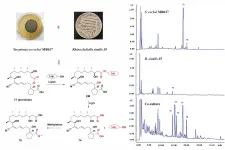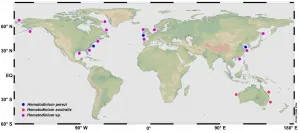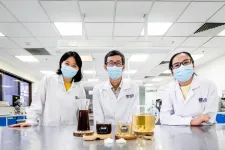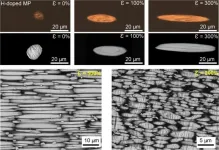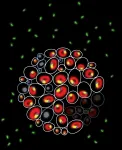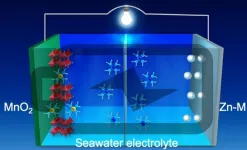Scientists identify workflow algorithm to predict psychosis
Cleverly combining artificial and human intelligence leads to improved prevention of psychosis in young patients
2021-01-11
(Press-News.org) Scientists from the Max Planck Institute of Psychiatry, led by Nikolaos Koutsouleris, combined psychiatric assessments with machine-learning models that analyse clinical and biological data. Although psychiatrists make very accurate predictions about positive disease outcomes, they might underestimate the frequency of adverse cases that lead to relapses. The algorithmic pattern recognition helps physicians to better predict the course of disease.
The results of the study show that it is the combination of artificial and human intelligence that optimizes the prediction of mental illness. "This algorithm enables us to improve the prevention of psychosis, especially in young patients at high risk or with emerging depression, and to intervene in a more targeted and well-timed manner" explains Koutsouleris.
The algorithm does not replace treatment by medical professionals; rather, it assists decision making and provides recommendations as to whether to conduct further examinations on an individual basis. Using the algorithm, practitioners can identify at an early stage the patients that need therapeutic intervention and those who do not. "The results of our study could help drive a reciprocal and interactive process of clinical validation and improve prognostic tools in real-world screening services," Koutsouleris summarizes.
INFORMATION:
Original publication
Nikolaos Koutsouleris; Dominic B. Dwyer; Franziska Degenhardt; et al
Multimodal Machine Learning Workflows for Prediction of Psychosis in Patients With Clinical High-Risk Syndromes and Recent-Onset Depression
JAMA Psychiatry
Published online December 2, 2020.
[Attachments] See images for this press release:

ELSE PRESS RELEASES FROM THIS DATE:
2021-01-11
The spiky structure that erupts from the smooth surface of a ferrofluid when a magnet is brought close can be predicted more accurately than previously thought. KAUST researchers have shown that computational algorithms can calculate the ferrofluid's bristling response to a magnet by simulating only the liquid's surface layer.
Ferrofluids are liquid suspensions of iron-based particles that behave like a regular fluid, but once a magnet is present, the ferrofluid rapidly shape-shifts to form spikes that align with the magnetic field. Originally developed by NASA, ferrofluids have numerous uses ranging from advanced electronics to nanomedicine and have the potential for even broader use, if their magnetic responses could be predicted more accurately.
Dominik Michels and ...
2021-01-11
Co-culture: stimulate the metabolic potential and explore the molecular diversity of natural products from microorganisms
Announcing a new publication for Marine Life Science & Technology journal. In this review article the authors Xiao-Yue Peng, Jin-Tao Wu, Chang?Lun Shao, Zhi-Yong Li, Min Chen and Chang-Yun Wang from the Ocean University of China, Qingdao, China, Yangzhou University, Yangzhou, China, Qingdao National Laboratory for Marine Science and Technology, Qingdao, China and Shanghai Jiao Tong University, Shanghai, China consider the metabolic potential and molecular diversity of natural products from microorganisms.
Microbial secondary metabolites have long ...
2021-01-11
Announcing a new publication for Marine Life Science & Technology journal. In this review article the authors Caiwen Li, Meng Li and Qian Huang from Institute of Oceanology, Chinese Academy of Sciences, Qingdao, China consider the impact of the parasitic dinoflagellate Hematodinium on aquaculture of marine crustaceans in China.
Hematodinium is a type of parasitic dinoflagellate that infects marine crustaceans globally. The parasite lives mainly in the hemolymph or hemocoels of affected hosts, and results in mortalities due to malfunction or loss of functions of major organs.
In recent years, the parasite has developed into an emerging epidemic pathogen not only affecting wild populations of economically valuable marine crustaceans ...
2021-01-11
Good news for those who need a cuppa to start the day. Researchers from the National University of Singapore (NUS) have created new probiotic coffee and tea drinks that are packed with gut-friendly live probiotics.
Supervised by Associate Professor Liu Shao Quan from the Department of Food Science and Technology at the NUS Faculty of Science, the two doctoral students who worked on these two new beverages assert that their drinks have a great taste, and can be stored chilled or at room temperature for more than 14 weeks without compromising on their probiotic viability.
Traditional probiotic carriers like yoghurts and cultured milks are dairy-based products. The rise in veganism, along with common health issues like lactose intolerance, high ...
2021-01-11
Today's electronic devices strive for new form factors - to make them foldable, stretchable, and deformable. To produce such devices that are highly stretchable or deformable, it is necessary to develop electrodes and circuit lines whose electrical properties can withstand harsh deformation or mechanical damage. To this, POSTECH-Yonsei University joint research team has recently developed liquid metal ink to accelerate printed electronic devices that can be changed into any shape.
Professor Unyong Jeong and Dr. Selvaraj Veerapandian of POSTECH's Department of Materials Science and Engineering, with Professor Aloysius Soon and Dr. Woosun Jang of Yonsei University's Department of Materials Science and Engineering, have developed liquid metal microparticles ...
2021-01-11
NIH-supported pilot study found team-based approach may improve buprenorphine care.
WHAT:
A collaborative approach to treating opioid use disorder that relies heavily on community pharmacists is feasible and may increase adherence and participant satisfaction, according to a pilot study published today in Addiction. The study was supported by the National Institute on Drug Abuse (NIDA), part of the National Institutes of Health, through the NIDA Center for the Clinical Trials Network.
Most people with opioid use disorder who would benefit from medication do not receive it. Buprenorphine is a safe and effective ...
2021-01-11
DALLAS - Jan. 11, 2021 - A set of biomarkers not traditionally associated with cell fate can accurately predict how genetically identical cells behave differently under stress, according to a UT Southwestern study. The findings, published by Cell Reports as a Dec. 1 cover story, could eventually lead to more predictable responses to pharmaceutical treatments.
Groups of the same types of cells exposed to the same stimuli often display different responses. Some of these responses have been linked to slight differences in genetics between individual cells. However, even genetically identical cells can diverge in ...
2021-01-11
As the planet continues to warm, the twin challenges of diminishing water supply and growing energy demand are intensifying. But because water and energy are inextricably linked, as we try to adapt to one challenge - say, by getting more water via desalination or water recycling - we may be worsening the other challenge by choosing energy-intensive processes.
So, in adapting to the consequences of climate change, how can we be sure that we aren't making problems worse?
Now, researchers at the Department of Energy's Lawrence Berkeley National Laboratory (Berkeley Lab), UC Berkeley, and UC Santa Barbara have developed a science-based analytic framework to evaluate such complex connections between water and energy, and options for adaptations in response to an evolving ...
2021-01-11
CORVALLIS, Ore. - Researchers in the Oregon State University College of Engineering have developed a battery anode based on a new nanostructured alloy that could revolutionize the way energy storage devices are designed and manufactured.
The zinc- and manganese-based alloy further opens the door to replacing solvents commonly used in battery electrolytes with something much safer and inexpensive, as well as abundant: seawater.
Findings were published today in Nature Communications.
"The world's energy needs are increasing, but the development of next-generation electrochemical energy storage systems with high energy density and long cycling life ...
2021-01-11
PULLMAN, Wash. - Biomarkers in human sperm have been identified that can indicate a propensity to father children with autism spectrum disorder. These biomarkers are epigenetic, meaning they involve changes to molecular factors that regulate genome activity such as gene expression independent of DNA sequence, and can be passed down to future generations.
In a study published in the journal Clinical Epigenetics on Jan. 7, researchers identified a set of genomic features, called DNA methylation regions, in sperm samples from men who were known to have autistic children. Then in a set of blind tests, the researchers were able to use the presence of these features to determine whether other men had fathered autistic children with 90% ...
LAST 30 PRESS RELEASES:
[Press-News.org] Scientists identify workflow algorithm to predict psychosis
Cleverly combining artificial and human intelligence leads to improved prevention of psychosis in young patients

